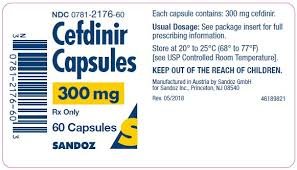
In the ever-evolving landscape of medicine, the battle against bacterial infections persists as a significant challenge. However, with the advent of antibiotics like cefdinir, healthcare professionals have gained a potent weapon in their arsenal. Cefdinir, a broad-spectrum cephalosporin antibiotic, has garnered attention for its efficacy in treating various bacterial infections across diverse patient populations. This article explores the pharmacology, uses, benefits, and potential side effects of cefdinir.
Understanding Cefdinir:
Cefdinir belongs to the third generation of cephalosporin antibiotics, which are derived from the fungus Acremonium. Like other cephalosporins, it exerts its antibacterial effects by inhibiting bacterial cell wall synthesis, ultimately leading to bacterial cell death. This mechanism of action makes cefdinir effective against a wide range of gram-positive and gram-negative bacteria.
Clinical Applications:
Cefdinir finds application in the treatment of various bacterial infections, including respiratory tract infections, skin and soft tissue infections, and acute exacerbations of chronic bronchitis. It is also indicated for the treatment of uncomplicated community-acquired pneumonia and acute maxillary sinusitis. Additionally, cefdinir is prescribed for certain pediatric infections, such as acute otitis media in children.
Efficacy and Benefits:
One of the key advantages of cefdinir is its broad spectrum of activity against both gram-positive and gram-negative bacteria. This makes it a versatile choice for empiric therapy, especially in settings where the exact pathogen may not be known. Moreover, cefdinir demonstrates good tissue penetration, allowing it to effectively target bacteria at the site of infection.
Another benefit of cefdinir is its relatively favorable safety profile. Clinical studies have shown that it is generally well-tolerated, with adverse effects being mild to moderate in severity. Common side effects may include gastrointestinal symptoms such as diarrhea, nausea, and abdominal pain. However, severe adverse reactions are rare, making cefdinir a generally safe option for most patients.
Dosage and Administration:
Cefdinir is available in oral formulation, typically as capsules or oral suspension. The dosage and duration of treatment vary depending on the type and severity of the infection, as well as the patient’s age and renal function. It is important for healthcare providers to follow established guidelines and adjust dosing regimens accordingly to optimize therapeutic outcomes and minimize the risk of adverse effects.
Resistance and Considerations:
As with any antibiotic, the emergence of bacterial resistance is a concern with cefdinir. Prolonged or inappropriate use of antibiotics can contribute to the development of resistance, limiting the efficacy of these drugs over time. Therefore, it is imperative for healthcare professionals to prescribe cefdinir judiciously and educate patients on the importance of completing the full course of treatment as prescribed.
Additionally, clinicians should be mindful of potential drug interactions when prescribing cefdinir, particularly with other medications metabolized by the liver or that may affect renal function. Close monitoring and dose adjustments may be necessary in patients with impaired hepatic or renal function to prevent toxicity and ensure therapeutic efficacy.
Future Directions:
As the field of antimicrobial stewardship continues to evolve, there is a growing emphasis on the rational use of antibiotics to preserve their effectiveness for future generations. This includes efforts to develop new antibiotics, as well as strategies to optimize the use of existing agents like cefdinir through surveillance, education, and adherence to evidence-based guidelines.
In conclusion, cefdinir represents a valuable tool in the management of bacterial infections, offering broad-spectrum activity, favorable tolerability, and convenient oral administration. However, its efficacy hinges on responsible prescribing practices and vigilant monitoring to minimize the risk of resistance and adverse effects. By harnessing the potential of cefdinir and other antibiotics judiciously, healthcare providers can continue to combat bacterial infections effectively while safeguarding the long-term effectiveness of these vital therapeutic agents.
